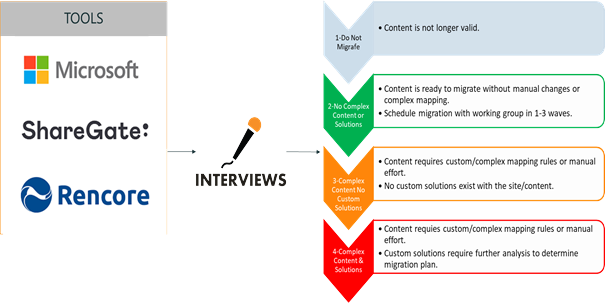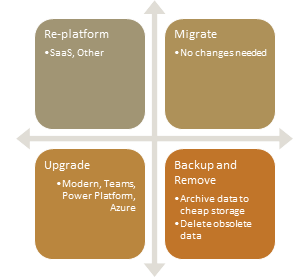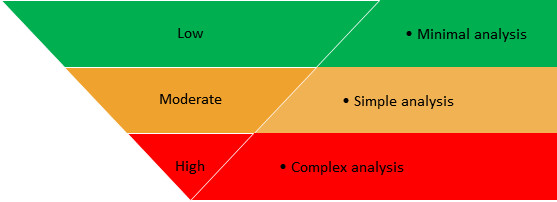- May 21, 2020
- Posted by: Todd Baginski
- Category: How-To

To properly create a SharePoint migration plan to Office 365, it’s important to understand your current environment. You need to determine what you already have, what you want to keep/archive/delete, and what requires reengineering.
This includes content, workflows, and business solutions created within your on-premises SharePoint environment. At Canviz, we use a four step process to assess SharePoint environments and create migration plans. Here’s what it looks like at a high level.
1. Create an assessment
Create an assessment of the current environment using a combination of tools and interviews. We like to organize the assessment finding into 4 buckets. These buckets make it easy to prioritize the work. The output of this step gives you a visual representation of what you need to work with.

2. Analyze the assessment findings
Analyze the assessment findings to determine how to migrate each site or solution. The following diagram illustrates the key categories items fall into when migrating.

3. Organize sites and content
Organize sites and content into 3 groups based on effort in terms your users can understand. These groups specify the level of effort required to migrate each piece. This helps set the priority and the order of migration activities, while also providing a good measuring scale to determine how long it will take to migrate.
For example, items that are classified in the Low effort category can be migrated sooner, producing quick wins. While items that require a High level of effort typically require additional analysis and reengineering before they are ready to migrate.
Typically, about 60% of your sites will be Low, while ~30% are Moderate and ~10% are High.

Technical requirements may also dictate priority. For example, records management capabilities should always be setup and configured first so the sites that follow can plug right into records management policies and be immediately compliant.
4. Create a migration schedule
Create a migration schedule that takes into account the level of effort and complexities identified in the previous steps. This should be considered a fluid document that will change as you work more intimately with each site and site owner throughout the migration process.
Canviz is ready to help you with any or all these activities, contact us today to get started. Learn more about our SharePoint Migration Services here.